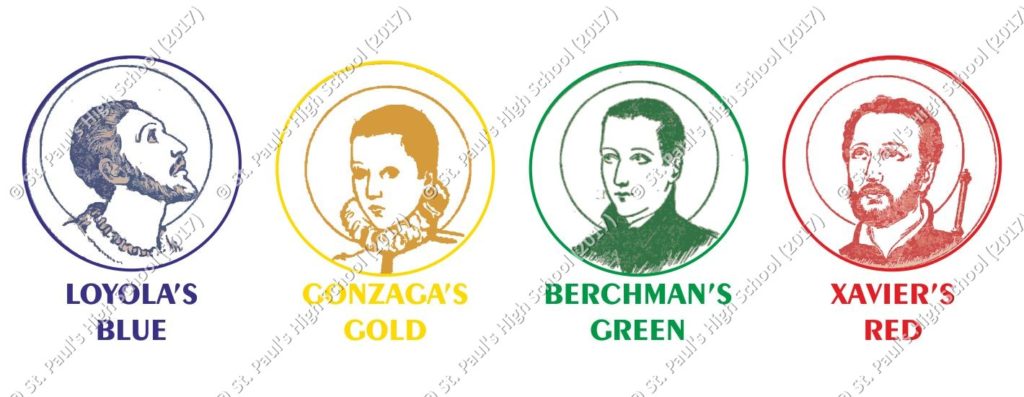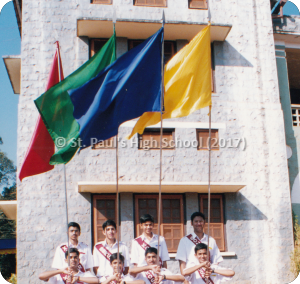
The House System was put into place in around 1956, the Centenary year of the School. The motto was to promote healthy competition between the students and make them work hard, to persevere and achieve the best of their capabilities in sports, academics and everything they did. The Houses are seen even today.
St. Paul’s is fortunate in having the house system, for it has helped a great deal in sowing the seeds of leadership. It inspires the spirit of competition and brings out the best in boys. It toughens all the aspects of school life and has become a part of tradition. The house system was started in around 1956, and was well in place by around the 1970’s. Although it has changed a lot from its initial stages, the concept still remains the same.
The school is divided into four houses – Blue, Gold, Green and Red. The boys can be identified by the houses to which they belong from the colour of the shoulder-tags they wear, as well as the colour of the pocket badges. Initially in around 1970’s, the boys wore these tags on all days except Saturdays, when they wore their house shirts and white pants.
Every group had an elected leader. Each class had four houses and each house in the class elected its own captain. Since the ninth class had four divisions (in the 1970’s), sixteen captains would stand for the election of the four commanders, one for each house. Only boys from the IX standard could stand for this office. These boys would give their speeches on a fixed day before the assembly and mention their credentials too. The teachers and all the boys from the VIII standard upwards had to cast their votes for the person they thought capable of leading each house. Thus the four commanders were elected.
From among the four commanders, the Prime-minister was elected. He was chosen by the teachers and the boys of the VIII standard upwards. The Prime Minister then went ahead with the help of the Deputy Prime Minister to appoint a cabinet of ministers to look after the different portfolios. Before starting their actual duties, the ministers and their deputies had to take an oath of office in front of the higher classes on the opening day of the school parliament. When this was over the work of the new ministers would begin. They saw to discipline, games, entertainment, information and cleanliness, among many other activities that they looked after. The ministers were mainly meant for maintaining of the standards of the school and catering to the needs of the boys in every way possible, Besides this, each class had four captains and a monitor. The Captains saw to the discipline of their respective houses in the class room. The monitor was in charge of the class and its responsibilities.
To bring about a sense of competition among the boys in the school, debates and question hours were held three to four times a year. In all these debates the participants got an opportunity to bring out their views on various topics and grow as individuals. A question hour was usually held before the debates, where the opposition would pull up the government for their lapses and the ministers in charge of the respective departments would give answers.
The house system worked very effectively for sports and games, and inculcated a healthy competitive spirit amidst the boys.

As the years went by, the sessions of the School Parliament were dropped because of the pressure of studies and the tight schedule of examinations prescribed by the Department. However the House System was continued especially in sports and games and academics. House Commanders and captains chose their own House teams for each sport from which later on the school teams were chosen. The stress was not only on individual performance and prizes but on winning points for the House team. On the Sports Day there was a Shield for the House scoring the highest number of points in sports and games. Besides there was an overall General Championship Shield for the House scoring the most marks in studies, sports, games and co-curricular activities. This fostered team spirit over individual performance. The house system continues even today, in this form, and is a way for the boys to compete among themselves and to become better at every activity they undertake.
Later, the cabinet system was also started for the primary section under the same guidelines, wherein the boys of IV standard would form the cabinet and take care of the primary section. This is also still prevailing today.
The Blue House

The Blue House has as its patron St. Ignatius of Loyola the founder of the Society of Jesus. Blue is the colour of the United Nations. It is also the background against which the Boy Scouts badge is printed. It symbolizes universality and with the two white wreaths on it, signifies peace.
Blue represents Ignatius’ great dream of winning the whole world for truth and justice the values of Jesus Christ. Ignatius himself was an officer in the Spanish royal army and was heroic in his loyalty to the Spanish King. He wanted to bring the whole world to acknowledge the values and ideals of Jesus Christ, who he understood to be a much greater and better King. He understood that Jesus Christ wanted all men to be his followers in so much as to live in love, brotherhood and self-sacrifice for the sake of others.
Therefore he took as his motto: For the ever greater glory of God.
This has to be the ideal of every boy of the Blue House, “The guiding light of his life — to work for love, brotherhood and peace based on truth and justice, at the cost of a lot of self-sacrifice.”
The Gold House

In our daily world gold is something that we consider precious, something worth possessing. We talk of a person of sterling character being tested in the fire as gold is purified in the fire. So gold is a symbol of integrity, purity and value.
Aloysius of Gonzaga came from the aristocracy and was born in the lap of luxury and royalty which had all the temptations of the time. However, he treasured his purity and uprightness more than all the gold and silver that were his for the asking. He renounced his earthly family inheritance in favour of his younger brother in order to become a Jesuit.
At a young age he put himself out in the service of the plague stricken in Italy literally carrying them to the hospital. He thus caught the dreaded disease from one of the sick. He died due to this, but he considered the joys of eternity of greater value than all his earthly riches or even his earthly life. He frequently asked himself the question, which he also places before each boy of the Gold house: “Whatever my actions and desires, how do they help for eternity?”
The Green House

Green is the colour of the fertile land and represents the fruitfulness of the common earth and the ordinary man. St. John Berchman is the patron of the Green house. He was a good Fleming and born in an ordinary middle class tanner’s family. He worked hard at his studies, played, prayed and helped in household chores. He was a young man with a very determined purpose.
There was nothing extraordinary about him or his gifts. But he worked hard to do everything to the best of his ability. For this reason he chose as his ideal: To do ordinary things extraordinarily well.
In the Society of Jesus, which he joined and in which he died very young, he was very mature for his age.
This, is the ideal, he holds out to every boy of the Green house — “To make all one’s hidden talents, no matter how insignificant they might be, flower and blossom. To do everything to the best of one’s ability. Even if you feel you are ordinary, aim for the stars. Nothing is impossible if one is willing to strive and work hard.”
The Red House

In the Middle Ages red was the sign of magnanimity and fortitude, even though today it is a symbol of the Communists and revolution, associated with anarchy. But originally it was a symbol of burning embers and symbolized burning love. It is also a symbol of the Red Cross and represents service to the suffering.
Francis Xavier is the patron of the Red House. As a young man at the University of Paris, he had great ambitions and was outstanding in sports. While he was entertaining big ambitions, he met Ignatius of Loyola who reminded him that the goals of this world are fleeting and empty. He was captivated by those words: What does it profit if you gain the whole world, but suffer the loss of your own soul? This set him thinking.
Later he was captivated by the idea of spreading Christ’s love to others in the world. Restlessly he went from country to country for this purpose. He traversed continents to fulfil this dream.
He places before the boys of the Red house this idea of “dreaming big things with a heart as large as the world. Placing your heart on things greater than this world can offer.”
